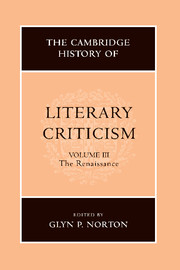Book contents
- Frontmatter
- Introduction
- READING AND INTERPRETATION: AN EMERGING DISCOURSE OF POETICS
- POETICS
- I Humanist classifications
- II The rediscovery and transmission of materials
- III Rhetorical poetics
- 13 Humanist education
- 14 Second rhetoric and the grands rhétoriqueurs
- 15 The rhetoric of presence: art, literature, and illusion
- 16 The paradoxical sisterhood: ‘ut pictura poesis’
- 17 Conceptions of style
- 18 Sir Philip Sidney's An apology for poetry
- 19 Aristotle, Horace, and Longinus: the conception of reader response
- IV Literary forms
- THEORIES OF PROSE FICTION
- CONTEXTS OF CRITICISM: METROPOLITAN CULTURE AND SOCIO-LITERARY ENVIRONMENTS
- VOICES OF DISSENT
- STRUCTURES OF THOUGHT
- NEOCLASSICAL ISSUES: BEAUTY, JUDGEMENT, PERSUASION, POLEMICS
- A SURVEY OF NATIONAL DEVELOPMENTS
- Bibliography
- Index
- References
16 - The paradoxical sisterhood: ‘ut pictura poesis’
from III - Rhetorical poetics
Published online by Cambridge University Press: 28 March 2008
- Frontmatter
- Introduction
- READING AND INTERPRETATION: AN EMERGING DISCOURSE OF POETICS
- POETICS
- I Humanist classifications
- II The rediscovery and transmission of materials
- III Rhetorical poetics
- 13 Humanist education
- 14 Second rhetoric and the grands rhétoriqueurs
- 15 The rhetoric of presence: art, literature, and illusion
- 16 The paradoxical sisterhood: ‘ut pictura poesis’
- 17 Conceptions of style
- 18 Sir Philip Sidney's An apology for poetry
- 19 Aristotle, Horace, and Longinus: the conception of reader response
- IV Literary forms
- THEORIES OF PROSE FICTION
- CONTEXTS OF CRITICISM: METROPOLITAN CULTURE AND SOCIO-LITERARY ENVIRONMENTS
- VOICES OF DISSENT
- STRUCTURES OF THOUGHT
- NEOCLASSICAL ISSUES: BEAUTY, JUDGEMENT, PERSUASION, POLEMICS
- A SURVEY OF NATIONAL DEVELOPMENTS
- Bibliography
- Index
- References
Summary
The doctrine ut pictura poesis (‘as is’ or ‘as in painting, so is’ or ‘so in poetry’) lies at the heart of Renaissance aesthetics, the central theme and presiding dogma of the theory and practice of painting and poetry alike. Accompanied by the ‘witty antithesis’ attributed by Pliny (De gloria Atheniensium 3.347a) to Simonides of Chios, the chiastic poesia tacens, pictura loquens (‘painting is mute poetry, poetry a talking picture’), Horace's defining tag (Ars poetica 361) appears in virtually every treatise on art or poetry from the early Renaissance to the close of the Enlightenment. Now explicitly in the rehearsal of the Horatian and Simonidean watchwords, the ubiquitous ‘comparisons’ or ‘parallels’ of poetry and painting, or the recurrent paragone debating the relative value or ‘precedence’ of the Sister Arts, now implicitly in the perennial references to poetry not merely as Aristotelian ‘imitation’, but as painting, limning, drawing, sketching, colouring, depicting, or portraying, ut pictura is the universal presumption of all writers on poetry and poetics. It offers thus a key to understanding both what poetry was thought essentially to be and aim for and the place it occupied as the dominant mode of high cultural expression.
Yet despite the crucial role it played in Western aesthetics from the mid-fifteenth century down to Gotthold Ephraim Lessing's Laokoon of 1766, finally rejecting the doctrine on the basis of a critical reassessment of the formal ‘boundaries’ defining the irreducible differences between the so-called Sisters, the theory's actual content is surprisingly meagre. There was on one hand the set of commonplaces drawn from a scattering of ancient authorities and loci classici: the passages on imitation, plot, and the relationship between poetry and history in Aristotle's Poetics;
- Type
- Chapter
- Information
- The Cambridge History of Literary Criticism , pp. 168 - 175Publisher: Cambridge University PressPrint publication year: 1999
References
- 1
- Cited by



